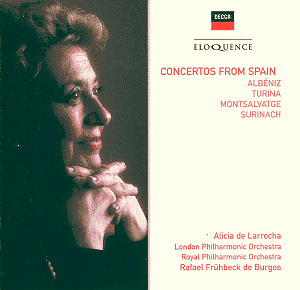Purists will insist
that the title of this disk should be
"Concertos from Catalunya"
since all the composers and the soloist
are Catalonians; some see their country
to be distinct from Spain. All the performances
are exceptional, as is to be expected
from these artists. I have recently
been greatly moved by de Larrocha’s
performances of Schubert, Liszt, Beethoven
and Mendelssohn, as well as the Granados
of whom her performances and scholarship
set a world standard. The recording
quality is among the finest I have ever
heard in a CD release, comparing in
range and impact to some SACDs.
The Turina and Albéniz
are colorful works in the Spanish style
easily accessible and thoroughly enjoyable
on first hearing. Turina was one of
the most "European" of the
Spanish composers in his piano sonatas
and chamber music but was still capable
of brilliant idiomatic writing in the
Spanish style, as here, with an underlying
sonata-form logic.
I have an enormous
regard for Surinach as a composer. He
was born and educated in Barcelona,
studied in Germany, and eventually emigrated
to the U.S. His works Tientos,
Cantos Berberes (3), and Ritmo
Jondo* are timeless masterpieces
in their style, and are among the works
I listen to most frequently. His choral
masterpiece Canciones de Alma
was recently recorded on a Guild CD
and is likely to join these earlier
works in my personal stellar firmament.
His skill as a conductor, developed
over many years of conducting in Barcelona,
Europe, and South America, was shown
in the first recording, on the MGM label,
of Hovhaness’s Symphony #9 "St.
Vartan," still the best
recording of the work ever made, sound
as well as performance*. At my initial
hearings of this Concerto, however,
expecting something very good, I reacted
very negatively to it. On subsequent
hearings I have come to enjoy and admire
it. He makes a number of very witty
and affectionate statements regarding
the work of Shostakovich whom he clearly
admires greatly. As with much of his
work, there is tremendous energy and
brilliant color; but underneath is a
sound musical structure which makes
the surface flesh all the more attractive
for the beautiful bone structure beneath.
Montsalvatge’s Concerto
Breve is not all that brief. Perhaps
the "breve" refers to the
time signature, or perhaps we are dealing
with a musical joke here, as when Schubert
labeled some of his most carefully thought-out
music "Impromptus."
In pronouncing Montsalvatge’s
name, observe that the TG in the Catalan
language is equivalent to the DG sound
in the English word "judge."
(I have to assume that Surinach is pronounced
to rhyme with the English word "notch.")
Montsalvatge was an icon of Catalan
music, a friend of de Larrocha’s, and
a beloved teacher. His music is difficult
to approach, but is lately becoming
better known and appreciated. He studied
in Paris and was hostile to the German
influence in music, preferring, like
Villa-Lobos, to construct his music
entirely of Latin stylistic elements.
But he is more consistently elegant
and more experimental than Villa-Lobos
and has none of the rhythmic savagery
of Surinach.
Montsalvatge’s music
is rigorously crafted but in a free
form with little of the recognizable
formulas. Every aspect from harmony
to texture to melody — or perhaps "linear
motion" would be a better word
— is under absolute control and the
result is a brilliantly original sound
design. No two of his works sound much
alike. This is not twelve tone music,
but it is not welcomingly tonal, either.
While the intricate, exciting tone color
will at once intrigue you, a deeper
enjoyment will come only after a number
of hearings, so be patient with this
music and the rewards will be great.
This disk has a curious
defect, one I’ve never before encountered.
It plays fine in most of my players,
but in my Emerson HD 7088 portable player,
playback stops for a few seconds every
few minutes, and sometimes one hears
a minute or two of digital hash before
playback resumes, always from exactly
the place where it stopped, making attentive
listening difficult with this player.
If I turn off the automatic anti-skip
feature, playback stops entirely. When
I first attempted to read the cue sheet
(the program on the CD which determines
the order and length of the tracks and
includes subcode information about copyrights
and royalties) in my Windows 2000 computer,
thinking there might be some irregularity
there, this caused the computer to reboot.
After all this, when I finally was able
to extract it, the cue sheet proved
to be strictly "Redbook,"
so the mystery persists. Perhaps, since
this disk was made in Australia, I should
have put it into the player upside down.
More seriously we may be dealing with
an unsuccessful experiment in compatible
copy protection that no one will own
up to. When you buy this disk, test
it on every player you own before the
dealer’s exchange period expires.
*I have restored these
recording to brilliant 96/24 digital
(monophonic) sound and am looking to
find an historical cd label willing
to release them commercially. My own
label, Pasigram, can only deal with
recordings fully in the public domain.
Paul Shoemaker


